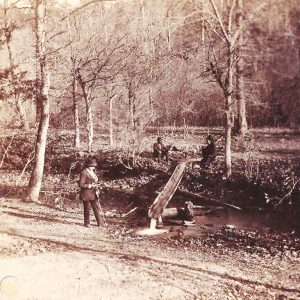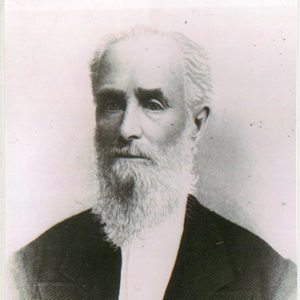calsfoundation@cals.org
Big Chalybeate Spring
The Big Chalybeate Spring is located approximately three miles north of downtown Hot Springs (Garland County) on present-day Park Avenue. Pronounced “kuh-lee-bit,” the spring is aptly named for its abundant iron and mineral content. References to the spring date as far back as December 7, 1804, during the Hunter-Dunbar Expedition commissioned by President Thomas Jefferson to survey the Louisiana Purchase, and again by Major Stephen Harriman Long during his January 1818 visit to Hot Springs. Having an average temperature of 79˚F, the spring is designated “thermal” by the United States National Oceanic and Atmospheric Administration.
References to the spring appear in the Arkansas Gazette in both 1827 and 1829 as a potential resort destination due to its strong hydrological discharge and medicinal qualities. Arkansas pioneer Hiram Abiff Whittington first developed commercial use of the spring in 1836 upon returning to the area from his native Boston, Massachusetts, with his new wife, Mary Burnham Whittington. Hiram Whittington had previously spent several years in the current-day Bathhouse Row area of Hot Springs and is widely credited with being one of the first to establish commerce in the area. While at Chalybeate Spring, he established a resort, started a novaculite mining operation, and was elected to two terms in the newly established Arkansas General Assembly. All six of the Whittington children were born while he and his wife were living here. Correspondence from Whittington to U.S. senator Chester Ashley on December 5, 1845, gives “Chalybeate Spring” as the return address. In 1849, Whittington moved from the Chalybeate Spring to Montgomery County, where he served another term in the state legislature before moving back to property in downtown Hot Springs he had purchased from U.S. senator Solon Borland.
By 1852, an Arkansas Gazette advertisement lists the former Whittington resort property as the “Randolph Chalybeate and Sulphur Springs,” complete with a bowling saloon, billiards, and a bar containing fine wine and liquors. A few years later, in May 1856, the Arkansas Gazette reported that the resort was under the ownership of Colonel Thomas Woodward.
From May 6 to July 15, 1862, Governor Henry Massie Rector, fearing a Union assault on Little Rock (Pulaski County), relocated the state government and archives to his home in downtown Hot Springs on the present-day location of the National Park Service’s Arlington Lawn. For reasons unknown, the office of the state auditor and state treasurer were located at the Chalybeate Springs resort. Several months later, the Davies family of Chicot County arrived with a caravan of wagons and 150 slaves to escape the effects of the war. They remained until the summer of 1863 before moving back home, fearing the recent fall of Little Rock to Union troops would soon mean the fall of Hot Springs as well.
As was the case for most of Hot Springs, all buildings located on the Chalybeate Springs property were burned down by war’s end. Plans to rebuild a resort in the area were reported by the Hot Springs Courier on September 23, 1869: “An elegant hotel will be built this winter at the Whittington Chalybeate, three miles from Hot Springs, for the reception of guests.”
Throughout the 1880s, newspapers reference the spring as a common meeting place and as a camp for railroad workers connecting Hot Springs to Mountain Valley. An 1891 report by the Arkansas Geological Survey described the spring’s mineral content in detail, in addition to its being “rectangular in shape, about 6 feet wide by 9 feet long and from 15 inches to 2 feet deep.” The discharge of the spring was reported to be 268,540 gallons every twenty-four hours.
By the beginning of the twentieth century, the Chalybeate Springs property remained a regular meeting and stopping place for locals and travelers from Little Rock and points east. However, the lure of the Hot Springs just down the road, and its related development, diminished the importance of Chalybeate Springs as a commercial and recreational attraction. By 1925, the section of Park Avenue/State Highway 7 had become one of the first paved stretches of road in Garland County. Construction of Interstate 30 and U.S. Highway 70, connecting the city to Little Rock in the 1960s, in effect bypassed the centuries-old route in front of the spring and led to further loss of significance. In the twenty-first century, the original Whittington property, believed to be in excess of 300 acres, is owned by numerous entities, including the National Park Service, the Nature Conservancy, and two commercial business operations—a bed and breakfast and an event venue located directly on the spring’s discharge. A handful of private residences are also found on the property, including one listed on the National Register of Historic Places.
For additional information:
Berry, Trey, Pam Beasley, and Jeanne Clements, eds. The Forgotten Expedition: The Louisiana Purchase Journals of Dunbar and Hunter, 1804–1805. Baton Rouge: Louisiana State University Press, 2006.
“Hot Springs of Arkansas.” New York Municipal-Gazette, April 1, 1848.
McDermott, John Francis. The Western Journals of Dr. George Hunter, 1796–1805. Philadelphia: The American Philosophical Society, 1963.
Pitcock, Len. “Big Chalybeate Spring.” The Record (2021): 5.1–5.6.
Rhodes, Larry. “The Forgotten Spa—Whittington’s Chalybeate.” The Greater Hot Springs Edition Vol. 5, no. 4 (May 1998).
Speer, William S. Encyclopedia of the New West. Easley, SC: Southern Historical Press, 1978.
Len Pitcock
Hot Springs, Arkansas
 Geography and Geology
Geography and Geology Big Chalybeate Spring
Big Chalybeate Spring  Hiram Whittington
Hiram Whittington 




Comments
No comments on this entry yet.